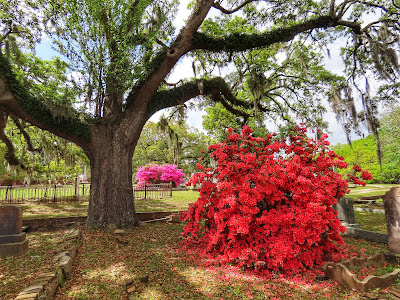In March and April, it has some of the best azaleas around. Keep reading for photos of azaleas at my house and at Magnolia Cemetery in Charleston.
After my Mass ended nearby, I decided to park near this church and walk around the grounds. The service was still going on inside so I was careful to keep my distance and be quick and quiet with my photography.
This is St. Paul’s Anglican Church. Built in 1857 to replace the church built nearby in 1830, it is one of Summerville’s oldest and most historic houses of worship.
It has ties with the Colonial Dorchester State Historic Site in that the church formed there in 1717, St. George's Parish Church, evolved into St. Paul's. At the park off Dorchester Road can be seen what remains of the church and its bell tower.
St. Paul's Anglican is Summerville’s oldest extant church with the second oldest congregation. Summerville Presbyterian has the oldest congregation.
I think it is safe to say that St. Paul’s has the most beautiful and abundant azalea bushes of perhaps any church in the Charleston area.
A churchyard wraps around the church. According to Find a Grave, more than 1,000 people are buried here. They include a Civil War Union (not Confederate) general and World War II U.S. fighter pilot. In February 1945, 2nd Lt. John David Alexander was flying a P-51 Mustang over Bavaria, Germany when he was killed. He was just 21 years old. He is buried in the Lorraine American Cemetery in France (more than 10,000 Americans who died in Europe in World War II are interred there). A small marker here at St. Paul’s is a “cenotaph” memorial.
On a return visit to the churchyard on June 2 I was able to find Lt. Alexander's cenotaph in a family plot just to the left of the church. I found it with the help of a nice lady in the church office. It helped too that American flags are still by the graves of military veterans. Memorial Day was last week.
Click on this image to better read the inscribed message about the Confederate soldiers being honored. The Memorial Day memorial was created and unveiled on this spot by the
C. Irvine Chapter No. 190 of the United Daughters of the Confederacy. I found this 2017 article about how the chapter, first chartered in 1898, was being reactivated.
"Widows would call and ask him to take care of their husbands’ graves. He would dig up azaleas and camellias in our yard and transplant them around the graves of friends and family at St. Paul’s. Then, he would load up a truckload of manure from our stables or the farm and fertilize the plants. I have seen photos before and after Dad started planting bushes. There is quite a difference.’”
Happy Easter to all and thank you St. Paul’s Church for the blessing of this spring treat each year!
Alas, as I’m writing this on Sunday, April 6 the vibrant flowers are already falling to the ground. All too short is our azalea season.
Another place where I enjoy photographing azaleas is Magnolia Cemetery. I have written books about this beautiful and historic Victorian necropolis. See my book information at the top of this blog and on my Amazon author site.
Magnolia Cemetery’s 150 acres are filled with gravestones of all shapes and sizes, complemented by diverse trees, plants and brilliant azalea bushes in places.
It is fun to photograph such beauty especially knowing how the full-glory azalea bloom usually lasts only a month or so.









.jpg)
.jpg)



















2 comments:
Fast post and absolutely stunning photos. Happy Easter to you ❤️
Thank you for the nice comments! Is this your church by chance?
Post a Comment